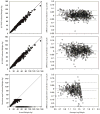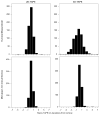Evaluation of the Mercy TAPE: performance against the standard for pediatric weight estimation
- PMID: 23602655
- PMCID: PMC4039210
- DOI: 10.1016/j.annemergmed.2013.02.021
Evaluation of the Mercy TAPE: performance against the standard for pediatric weight estimation
Abstract
Study objective: We assessed the performance of 2 new devices (2D- and 3D-Mercy TAPE) to implement the Mercy Method for pediatric weight estimation and contrasted their accuracy with the Broselow method.
Methods: We enrolled children aged 2 months through 16 years in this prospective, multicenter, observational study. Height/length, weight, humeral length, and mid-upper arm circumference were obtained for each child, using calibrated scales and measures. We then made measurements with blinded versions of the 2D- and 3D-TAPEs. Using height/length data, we calculated the weight estimated by the Broselow method. We contrasted measures with mean error, mean percentage error, and percentage predicted within 10% and 20% of actual.
Results: Six hundred twenty-four participants (median 8.5 years, 27.6 kg, 17.3 kg/m(2)) completed the study. Mean error was 0.3 kg (mean percentage error 1.6%), 0.2 kg (mean percentage error 1.9%), and -1.3 kg (mean percentage error -4.1%) for 2D-, 3D-, and Broselow, respectively. Concordance between both TAPE devices and the Mercy Method was greater than 0.99. The proportion of children predicted within 10% and 20% of actual weight was 76% and 98% for the 2D-TAPE and 65% and 93% for the 3D-TAPE. Excluding the 209 (33%) children who were too tall for the device, Broselow predictions were within 10% and 20% of actual weight in 59% and 91%.
Conclusion: The 2D- and 3D-Mercy TAPEs outperform the Broselow tape for pediatric weight estimation and can be used in a wider range of children.
Trial registration: ClinicalTrials.gov NCT01507090.
Copyright © 2013 American College of Emergency Physicians. Published by Mosby, Inc. All rights reserved.
Figures



Similar articles
-
Accuracy of Weight Estimation in Children Using the Broselow, PAWPER XL, PAWPER XL-MAC, and Mercy Tapes.Pediatr Emerg Care. 2022 Sep 1;38(9):e1517-e1522. doi: 10.1097/PEC.0000000000002638. Epub 2022 Feb 8. Pediatr Emerg Care. 2022. PMID: 36040471
-
The Broselow and Handtevy Resuscitation Tapes: A Comparison of the Performance of Pediatric Weight Prediction.Prehosp Disaster Med. 2016 Aug;31(4):364-75. doi: 10.1017/S1049023X16000455. Epub 2016 May 25. Prehosp Disaster Med. 2016. PMID: 27221240
-
Estimating the weight of ethnically diverse children attending an Australian emergency department: a prospective, blinded, comparison of age-based and length-based tools including Mercy, PAWPER and Broselow.Arch Dis Child. 2017 Jan;102(1):46-52. doi: 10.1136/archdischild-2016-310917. Epub 2016 Oct 31. Arch Dis Child. 2017. PMID: 27799153 Free PMC article.
-
The accuracy of the Broselow tape as a weight estimation tool and a drug-dosing guide - A systematic review and meta-analysis.Resuscitation. 2017 Dec;121:9-33. doi: 10.1016/j.resuscitation.2017.09.026. Epub 2017 Sep 25. Resuscitation. 2017. PMID: 28958796 Review.
-
Weight Estimation Methods in Children: A Systematic Review.Ann Emerg Med. 2016 Oct;68(4):441-451.e10. doi: 10.1016/j.annemergmed.2016.02.043. Epub 2016 Apr 19. Ann Emerg Med. 2016. PMID: 27105839 Review.
Cited by
-
Development and Validation of a Weight Estimation Tool for Acutely Ill Children Who Cannot be Weighed.Indian J Pediatr. 2024 Apr;91(4):344-350. doi: 10.1007/s12098-023-04600-1. Epub 2023 Jul 4. Indian J Pediatr. 2024. PMID: 37402105
-
Weight estimation in two groups of Ghanaian children with chronic diseases using Broselow, Mercy, PAWPER XL and PAWPER XL-MAC tapes.Afr J Emerg Med. 2023 Jun;13(2):109-113. doi: 10.1016/j.afjem.2023.04.003. Epub 2023 Apr 26. Afr J Emerg Med. 2023. PMID: 37152659 Free PMC article.
-
Validity of Broselow tape for estimating the weight of children in pediatric emergency: A cross-sectional study.Front Pediatr. 2022 Aug 16;10:969016. doi: 10.3389/fped.2022.969016. eCollection 2022. Front Pediatr. 2022. PMID: 36052355 Free PMC article.
-
Comparison of paediatric weight estimation methods at a tertiary hospital in Ghana.Afr J Emerg Med. 2021 Jun;11(2):252-257. doi: 10.1016/j.afjem.2021.03.005. Epub 2021 Apr 5. Afr J Emerg Med. 2021. PMID: 33859928 Free PMC article.
-
Pediatric weight estimation: validation of the PAWPER XL tape and the PAWPER XL tape mid-arm circumference method in a South African hospital.Clin Exp Emerg Med. 2020 Dec;7(4):290-301. doi: 10.15441/ceem.19.082. Epub 2020 Dec 31. Clin Exp Emerg Med. 2020. PMID: 33440107 Free PMC article.
References
-
- Garland JS, Kishaba RG, Nelson DB, Losek JD, Sobocinski KA. A rapid and accurate method for estimating body weight. Am J Emerg Med. 1986;4:390–3. - PubMed
-
- Lubitz D, Seidal JS, Chameides L, Luten RC, Zaritsky AL, Campbell FW. A rapid method for estimating weight and resuscitation drug dosages from length in the pediatric age group. Ann Emerg Med. 1988;17:576–81. - PubMed
-
- Molyneux E, Brogan R, Mitchell G, Gove S. Children’s weights: guess or measure by tape? Lancet. 1999;354:1616. - PubMed
-
- The Advanced Life Support Committee of the Australian Resuscitation Council. Paediatric advanced life support - the Australian resuscitation council guidelines. MJA. 1996;165:199–206. - PubMed
Publication types
MeSH terms
Associated data
Grants and funding
LinkOut - more resources
Full Text Sources
Other Literature Sources
Medical

